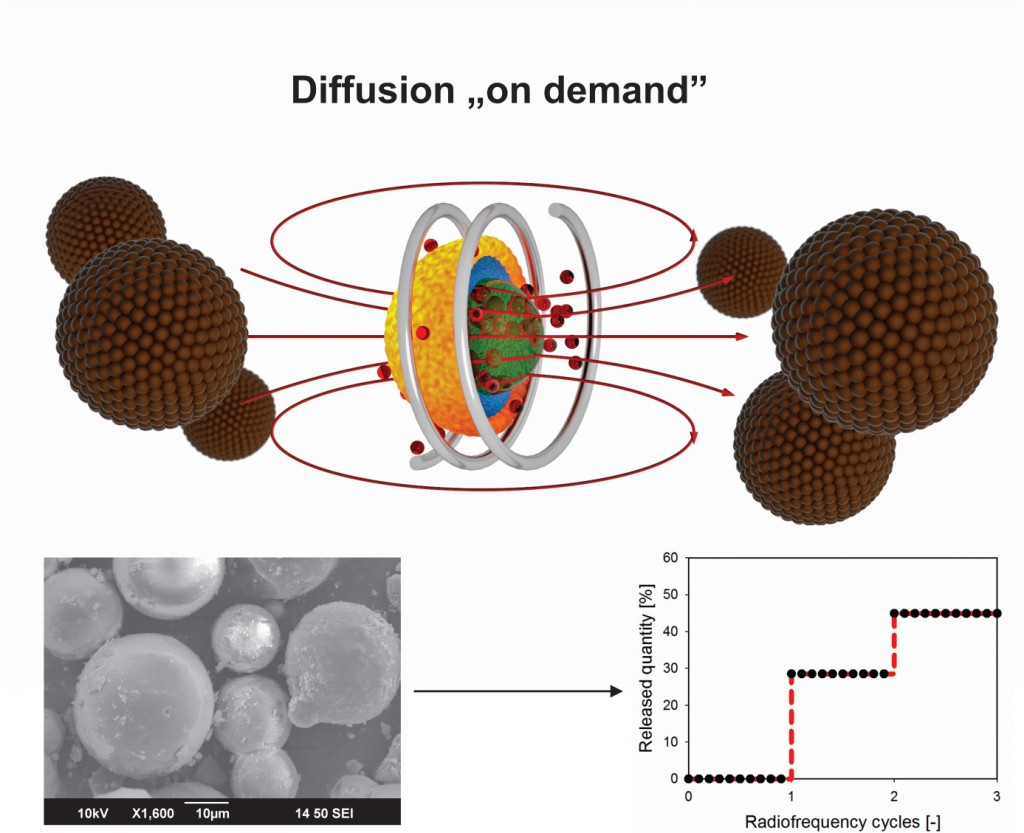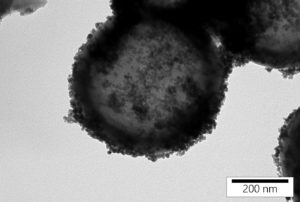Marek Šoltys, Martin Balouch, David Zůza, Zuzana Kremláčková, Pavel Kovačík, František Štěpánek
Preparation of core-shell structured or highly porous dense silica particles can be divided in two main categories. One is synthesis of micro-particles which are usually more simple to prepare and more easy to work with and the other is synthesis of nano-particles, where we try to mimic or even enhance the behaviour of micro-particles, but on a nano-scale in order for the particles to be more suitable for their planned in-vivo and other applications.
Composite hollow core composite silica/iron oxide spheres are prepared via the soft templating method. Depending on the method and its parameters we prepare hollow spheres with a mean size ranged from tens of nanometers to tens of micrometers. Prepared particles have the ability to store an encapsulated payload and release a defined quantity “on demand” by the application of a radiofrequency magnetic field. Apart from the release of pre-existing encapsulated substance, these microparticles open the opportunity to exploit the local heating also for other temperature-dependent phenomena, such as phase transitions, liquid-liquid extraction or chemical reactions. Our work on composite core-shell particles was featured on the front cover of the October 2013 issue of the Chemical Engineering Journal.

Fig. 1: Diffusion of encapsulated substances occurs if the radiofrequency field is switched on due to rapid increase of temperature on the micro-particles surface.
Recently we focus on improving our composite particles by adding thermoresponsive barrier which ensures the controlled diffusion of encapsulated substances from the hollow core across the particle shell. Two coating approaches are used: i) so-called polymer brushes systems and ii) covering the surface of spheres by a phase change material.
- Zůza D., Šoltys M., Mužík J., Lizoňová D., Lhotka M., Ulbrich P., Kašpar O., Štěpánek F., “Silica particles with three levels of porosity for efficient melt amorphisation of drugs”, Micropor. Mesopor. Mater. 274, 61-69 (2019)
- Lanč M., Sysel P., Šoltys M., Štěpánek F., Fónod K., Klepić M., Vopička O., Lhotka M., Ulbrich P., Friess K., “Synthesis, preparation and characterization of novel hyperbranched 6FDA-TTM based polyimide membranes for effective CO2 separation: Effect of embedded mesoporous silica particles and siloxane linkages”, Polymer 144, 33-42 (2018).
- Šoltys M., Balouch M., Kašpar O., Lhotka K., Ulbrich P., Zadražil A., Kovačík P., Štěpánek F., “Evaluation of scale-up strategies for the batch synthesis of dense and hollow mesoporous silica microspheres”, Chem. Eng. J. 334, 1135-1147 (2018)
- Šoltys M., Kovačík P., Lhotka M., Ulbrich P., Zadražil A., Štěpánek F., “Radiofrequency controlled release from mesoporous silica nano-carriers”, Micropor. Mesopor. Mater. 229, 14-21 (2016)
- Kovačík P., Singh M., Štěpánek F., “Remote control of diffusion from magnetic hollow silica microspheres”, Chem. Eng. J. 232, 591-598 (2013)
- Kovačík P., Kremláčková Z., Štěpánek F., “Investigation of radiofrequency induced release kinetics from magnetic hollow silica microspheres”, Micropor. Mesopor. Mater. 159, 119-125 (2012)

